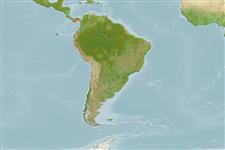Common names from other countries
>
Blenniiformes (Blennies) >
Blenniidae (Combtooth blennies) > Salariinae
Etymology: Scartichthys: Greek, skaritis, -idos = a jewel stone with the colour of the fish scarus (Ref. 45335); gigas: Latin, gigas = giant; refers to the relatively large size of adults (Ref. 10696).
More on author: Steindachner.
Environment: milieu / climate zone / depth range / distribution range
Ecologia
marino demersale; distribuzione batimetrica 0 - 10 m. Tropical; 9°N -
Eastern Pacific: Panama (Ref. 9280) to northern Chile (Ref. 10696).
Size / Peso / Age
Maturity: Lm ? range ? - 13 cm
Max length : 25.1 cm TL maschio/sesso non determinato; (Ref. 122662)
Short description
Chiavi di identificazione | Morfologia | Morfometria
Spine dorsali (totale) : 11 - 13; Raggi dorsali molli (totale) : 16 - 18; Spine anali: 2; Raggi anali molli: 18 - 20. With fewer than 70 dentary incisors and a reticulated color pattern.
Adults inhabit rocky coasts (Ref. 9280). They feed on plants, small mollusks and crustaceans (Ref. 9280). Oviparous (Ref. 205). Eggs are deposited in mollusk shells or on rocks (Ref. 9280). Larvae are planktonic, often found in shallow, coastal waters (Ref. 94114). Used to prepare a soup called 'borracho' which evokes slight intoxication and tiredness; these effects, however, are of short duration (Ref. 9280).
Oviparous, distinct pairing (Ref. 205).
Hastings, P.A., 1995. Blenniidae. Borrachos. p. 927-930. In W. Fischer, F. Krupp, W. Schneider, C. Sommer, K.E. Carpenter and V. Niem (eds.) Guia FAO para Identification de Especies para lo Fines de la Pesca. Pacifico Centro-Oriental. 3 Vols. FAO, Rome. (Ref. 9280)
IUCN Red List Status (Ref. 130435)
CITES (Ref. 128078)
Not Evaluated
Human uses
Pesca: scarso interesse commerciale
Strumenti
Special reports
Download XML
Fonti Internet
Estimates based on models
Preferred temperature (Ref.
115969): 18.1 - 26.8, mean 20.5 (based on 113 cells).
Phylogenetic diversity index (Ref.
82804): PD
50 = 0.5625 [Uniqueness, from 0.5 = low to 2.0 = high].
Bayesian length-weight: a=0.00813 (0.00434 - 0.01522), b=3.02 (2.85 - 3.19), in cm Total Length, based on LWR estimates for this species & (Sub)family-body (Ref.
93245).
Trophic level (Ref.
69278): 3.0 ±0.39 se; based on food items.
Resilienza (Ref.
120179): Medio, tempo minimo di raddoppiamento della popolazione 1.4 - 4.4 anni (Assuming tm=1 and Fec=100-1000).
Fishing Vulnerability (Ref.
59153): Low vulnerability (15 of 100).
